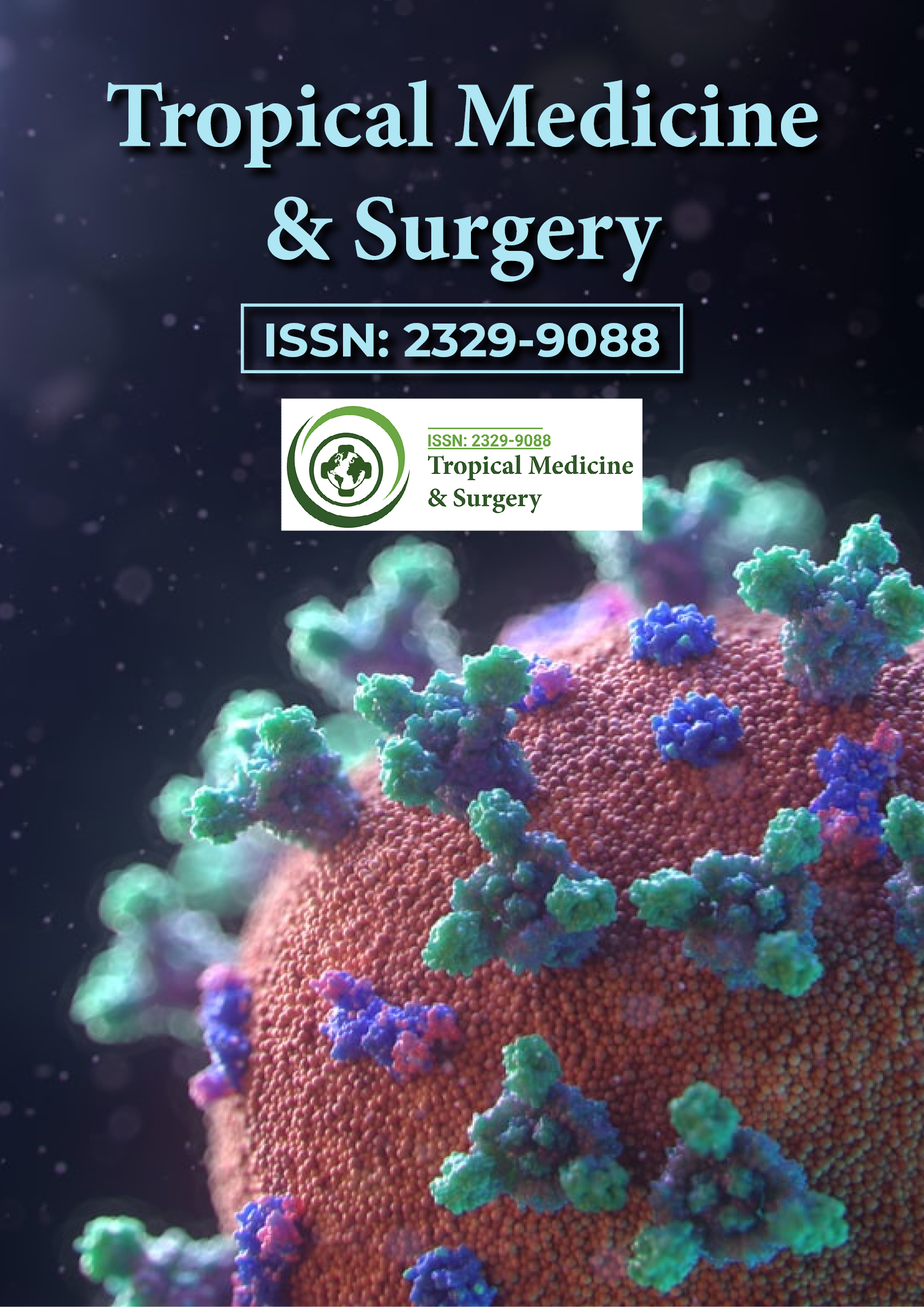Indexed In
- Open J Gate
- Academic Keys
- RefSeek
- Hamdard University
- EBSCO A-Z
- OCLC- WorldCat
- Publons
- Euro Pub
- Google Scholar
Useful Links
Share This Page
Journal Flyer

Open Access Journals
- Agri and Aquaculture
- Biochemistry
- Bioinformatics & Systems Biology
- Business & Management
- Chemistry
- Clinical Sciences
- Engineering
- Food & Nutrition
- General Science
- Genetics & Molecular Biology
- Immunology & Microbiology
- Medical Sciences
- Neuroscience & Psychology
- Nursing & Health Care
- Pharmaceutical Sciences
Commentary - (2025) Volume 13, Issue 1
Deciphering the Role of m6A RNA Modifications to Talaromyces marneffei and HIV co-infection: Insights and Implications
Sanqi An*Received: 07-Mar-2024, Manuscript No. TPMS-24-25106; Editor assigned: 11-Mar-2024, Pre QC No. TPMS-24-25106 (PQ); Reviewed: 25-Mar-2024, QC No. TPMS-24-25106; Revised: 24-Apr-2025, Manuscript No. TPMS-24-25106 (R); Published: 02-May-2025, DOI: 10.4172/2329-9088.25.13.389
Description
Talaromyces marneffei (TM), a thermally dimorphic pathogenic fungus, represents a critical health concern for individuals with compromised immune systems, especially for patients suffering from AIDS in tropical and subtropical areas. This fungus can switch between yeast and mold forms depending on the temperature, a feature that facilitates its pathogenicity and complicates treatment efforts. The interaction between TM infection and HIV presents a unique challenge, exacerbating the vulnerability of patients and demanding innovative approaches to treatment and understanding [1]. By exploring the role of N6- methyladenosine (m6A) modifications in TM/HIV co-infections, the research will open a new avenue in the study of infectious diseases. Our previous study's focus on the dynamic and reversible nature of m6A modifications, controlled by methyltransferases and demethylases and recognized by YTH family proteins, is groundbreaking [2,3]. It highlights a novel aspect of how RNA modifications can regulate immune responses in the context of complex co-infections.
Our finding demonstrates that TM infection leads to an increase in m6A modifications, altering the host's transcriptome and enhancing the immune system's susceptibility to further damage by HIV [4]. This increase in m6A levels, as observed through m6A-seq and ELISA experiments, suggests a sophisticated mechanism by which TM and HIV co-infection exacerbates the host's immune response decline, accelerating disease progression. The identification of the YTHDC2-TLR2 signaling axis as a critical pathway in this process provides a valuable insight into the molecular interactions at play during coinfection [5].
Furthermore, the study's findings on the up-regulation of YTHDC2 in TM-infected cells and its potential regulatory effect on TLR2 mRNA through m6A modification sites offer a promising target for therapeutic intervention. The observation that YTHDC2 knockout reduces TM and HIV replication in infected cells underscores the potential for targeting this pathway to alleviate the burden of TM/HIV co-infections.
While the study sheds light on the complex interplay between m6A modifications and immune response in TM/HIV coinfections, several challenges remain.
Future research endeavors should pivot towards the comprehensive exploration of the therapeutic implications of modulating the m6A landscape as a strategic measure to combat the complex challenges presented by TM/HIV co-infections. This includes a detailed examination of how altering m6A modification patterns could potentially impair the lifecycle of the TM fungus and the HIV virus, thereby mitigating the severity of co-infections. Such an approach could revolutionize our current treatment paradigms, offering more precisiontargeted therapies that directly interfere with the pathogens' RNA-based mechanisms of pathogenicity and immune evasion.
Moreover, extending the investigation into the role of m6A modifications beyond the realm of TM/HIV co-infections could illuminate universal mechanisms underpinning pathogenesis and host immunity across a broad spectrum of infectious diseases. This could lead to the discovery of shared m6A-driven regulatory pathways that various pathogens exploit to thrive within their hosts, offering insights into a common vulnerability that could be leveraged for therapeutic gains.
Crucially, the identification and characterization of specific m6A regulators comprising "writers," "erasers," and "readers" involved in the addition, removal, and recognition of these modifications, respectively hold the promise of uncovering novel molecular targets for therapeutic intervention. Targeting these m6A modifiers with small molecules or biologics could allow for the fine-tuning of the host's RNA landscape, thereby inhibiting critical processes necessary for pathogen survival and replication without disrupting the host's normal cellular functions.
By focusing on these strategic areas, future research could pave the way for the development of innovative treatments not only for TM/HIV co-infections but also for a wider array of infectious diseases.
References
- Li Y, Wei W, An S, Jiang J, He J, Zhang H, et al. Identification and analysis of lncRNA, microRNA and mRNA expression profiles and construction of ceRNA network in Talaromyces marneffei-infected THP-1 macrophage. PeerJ. 2021;9:e10529.
[Crossref] [Google Scholar] [PubMed]
- An S, Xie Z, Liao Y, Jiang J, Dong W, Yin F, et al. Systematic analysis of clinical relevance and molecular characterization of m6A in COVID-19 patients. Genes Dis. 2022;9(5):1170.
[Crossref] [Google Scholar] [PubMed]
- An S, Huang W, Huang X, Cun Y, Cheng W, Sun X, et al. Integrative network analysis identifies cell-specific trans regulators of m6A. Nucleic Acids Res. 2020;48(4):1715-1729.
[Crossref] [Google Scholar] [PubMed]
- Chu J, Zheng R, Chen H, Chen Y, Lin Y, Li J, Wei W, Chen R, Deng P, Su J, Jiang J. Dynamic m6A profiles reveal the role of YTHDC2â?TLR2 signaling axis in Talaromyces marneffei infection. J Med Virol. 2024;96(2):e29466.
[Crossref] [Google Scholar] [PubMed]
- Xu J, Liu LY, Zhi FJ, Song YJ, Zhang ZH, Li B, et al. DDX5 inhibits inflammation by modulating m6A levels of TLR2/4 transcripts during bacterial infection. EMBO reports. 2024;25(2):770-795.
[Crossref] [Google Scholar] [PubMed]
Citation: An S (2025) Deciphering the Role of m6A RNA Modifications to Talaromyces marneffei and HIV co-infection: Insights and Implications. Trop Med Surg. 13:389.
Copyright: © 2025 An S. This is an open-access article distributed under the terms of the Creative Commons Attribution License, which permits unrestricted use, distribution and reproduction in any medium, provided the original author and source are credited.
